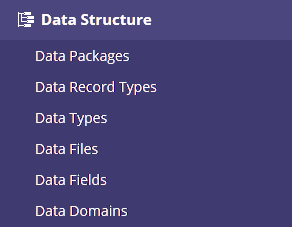Using the Navigation Area
The navigation area provides access to the pathways—entry points for navigating the metadata stored in Rochade. Each pathway corresponds to a specific range of data (for example, metadata obtained by analyzing software systems in your enterprise).
This table lists the available pathways (the number and order of the pathways depend on your user settings and access permissions):
|
Pathway |
Description |
|
|
Big Data |
Entry point for big data systems and the data warehouse structures built on top of them. |
|
|
|
Hive Data Warehouse |
Provides access to metadata that have been obtained by analyzing Apache Hive data warehouse structures. |
|
|
Hadoop File System |
Provides access to metadata that have been obtained by analyzing Hadoop file system directories. |
|
|
Transformation |
Provides access to metadata that have been obtained by analyzing Apache Falcon, Apache Flume, Apache Sqoop, and HiveQL jobs. |
|
|
Landing Zone Flow |
Provides access to metadata that have been obtained by analyzing how data move into and out of big data systems. |
|
Business Glossary |
Entry point for glossary data. Provides access to glossaries and glossary contexts and the business terms and acronyms that are stored in them. |
|
|
Business Intelligence |
Entry point for business intelligence systems. |
|
|
|
Reporting |
Provides access to metadata that have been obtained by analyzing business intelligence (BI) reports and reporting tools. |
|
|
OLAP: Online Analytical Processing |
Provides access to metadata that have been obtained by analyzing data warehouse online analytical processes (OLAP). |
| Data Import | Enables you to import data from an Excel file. See Running the Excel Import. | |
|
Data Quality Management |
Entry point for data quality items. Provides access to data quality measures and profiles. |
|
|
Data Structure |
Entry point for data structures. Provides access to metadata that have been obtained by analyzing the data structures used to store operational data. |
|
|
Favorites |
Entry point for the favorites list. Provides quick access to favorite views and items. |
|
|
Issue Management |
Entry point for the issue management facility. Provides access to issues (both open and closed issues). |
|
|
Models |
Entry point for entity-relationship (ER) model data. Provides access to metadata that have been obtained by analyzing the entities, attributes, identifiers, and relationships of ER models and the tables and columns of physical data models. |
|
|
Object-Oriented Definitions |
Entry point for OOP constructs. Provides access to metadata that have been obtained by analyzing packages, classes, interfaces, data types, methods, and variables. |
|
|
Reference Data |
Entry point for reference data. Provides access to data contexts and the data concepts that are stored in them. |
|
|
Relational Databases |
Entry point for relational database systems. Provides access to metadata that have been obtained by analyzing the databases, tables, and columns of database systems. |
|
|
Search |
Entry point for search categories. Provides quick access to the categories of search results. |
|
|
Stewardship & Workflow Management |
Provides access to the roles and workflows defined for use in EDI Browser, metaGlossary, and metaRDM. For more information about this pathway, see Administering Roles and Workflows. |
|
| Stitching | Provides access to the stitching container. See Stitching Metadata Items for details. | |
| Tags | Provides access to the tags management feature. See Tagging Feature for details. | |
|
Task Management |
Provides access to current and completed tasks and to governed items that are currently in process. |
|
|
Transformation |
Entry point for Extract, Transform, Load (ETL) processes. Provides access to metadata that have been obtained by analyzing data warehouse ETL processes. |
|
|
Version Management |
Entry point for the version management facility. Provides access to the work-in-progress area as well as functions for committing and discarding item modifications in the area. |
|
By following a pathway, you can query the metadata in the Rochade repository and produce lists of corresponding items. Each pathway has a number of subpaths that correspond to a specific type of metadata.
To expand a pathway to its subpaths
- Click the title bar of a collapsed pathway to expand it.
The Data Structure pathway, for example, has these subpaths:

- Click the title bar of an expanded pathway to collapse it.
For information on how to set a default for collapsed and expanded pathways, see Configuring Pathways in the Navigation Area.
- Click the Close button
 in the title bar of the pathway that you want to hide:
in the title bar of the pathway that you want to hide:

The Close button displays only when you hover the mouse over the pathway.
To display the pathway again, click its icon at the bottom of the navigation area:

Pathways that have been hidden temporarily will display again automatically the next time you log into EDI Browser. For information on how to hide a pathway permanently, see Configuring Pathways in the Navigation Area.
